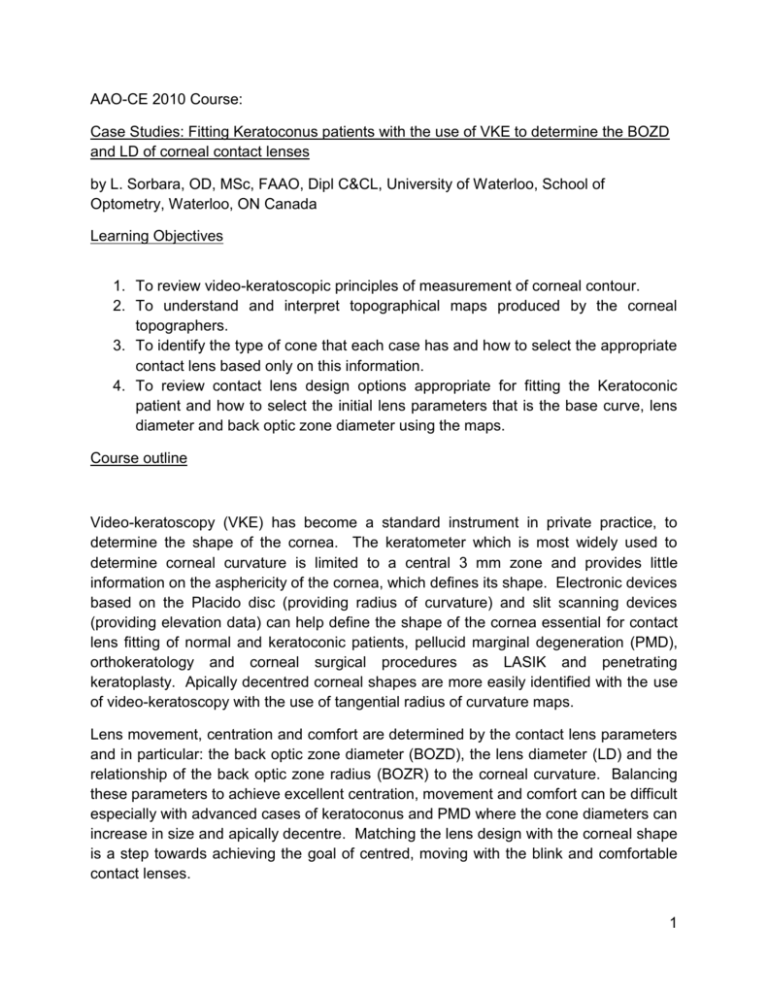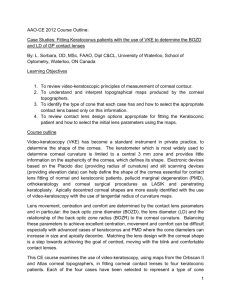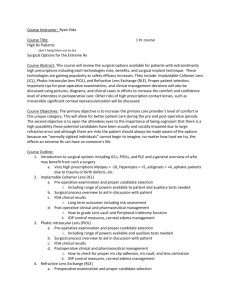outline26128
advertisement

AAO-CE 2010 Course: Case Studies: Fitting Keratoconus patients with the use of VKE to determine the BOZD and LD of corneal contact lenses by L. Sorbara, OD, MSc, FAAO, Dipl C&CL, University of Waterloo, School of Optometry, Waterloo, ON Canada Learning Objectives 1. To review video-keratoscopic principles of measurement of corneal contour. 2. To understand and interpret topographical maps produced by the corneal topographers. 3. To identify the type of cone that each case has and how to select the appropriate contact lens based only on this information. 4. To review contact lens design options appropriate for fitting the Keratoconic patient and how to select the initial lens parameters that is the base curve, lens diameter and back optic zone diameter using the maps. Course outline Video-keratoscopy (VKE) has become a standard instrument in private practice, to determine the shape of the cornea. The keratometer which is most widely used to determine corneal curvature is limited to a central 3 mm zone and provides little information on the asphericity of the cornea, which defines its shape. Electronic devices based on the Placido disc (providing radius of curvature) and slit scanning devices (providing elevation data) can help define the shape of the cornea essential for contact lens fitting of normal and keratoconic patients, pellucid marginal degeneration (PMD), orthokeratology and corneal surgical procedures as LASIK and penetrating keratoplasty. Apically decentred corneal shapes are more easily identified with the use of video-keratoscopy with the use of tangential radius of curvature maps. Lens movement, centration and comfort are determined by the contact lens parameters and in particular: the back optic zone diameter (BOZD), the lens diameter (LD) and the relationship of the back optic zone radius (BOZR) to the corneal curvature. Balancing these parameters to achieve excellent centration, movement and comfort can be difficult especially with advanced cases of keratoconus and PMD where the cone diameters can increase in size and apically decentre. Matching the lens design with the corneal shape is a step towards achieving the goal of centred, moving with the blink and comfortable contact lenses. 1 This CE course will examine the use of video-keratoscopy, using maps from the Orbscan II and Atlas corneal topographers, in fitting corneal contact lenses to four keratoconic patients. Each case has been selected to represent a type of cone (centred, oval or pellucid marginal degeneration) and range in severity from mild to severe. From each topographic map data needed to fit the correct lens diameter (LD) and back optic zone diameter (BOZD) will be extracted and related to the type and centration of the cone, along with its diameter. This course will attempt to increase the practitioners’ awareness and ease in managing these patients using a case study format. Topographic data to be collected: Simulated K readings/Average K readings Steepest K readings Centration/position of the cone Eccentricity value(s) Diameter of the steepest portion of the cone Diameter of the entire cone area Contact Lens Variable related to Topographic data: K readings relate to back optic zone radius (BOZR) i.e. cone severity Type of cone relates to type of lens (floating of fixed BOZD lenses) E values relate to axial edge lift of the lens periphery Diameter of the cone related to lens back optic zone diameter/overall diameter Once the diameters are determined, adjust back optic zone radius to compliment lens sagittal depth Reading References: Sorbara L, Chong T, Fonn D, (2000) Visual Acuity of Keratoconic Eyes as a Function of Rigid Gas Permeable Contact Lens Base Curves, Contact Lens and Anterior Eye, 23:2,48-52. Sorbara L, Luong J. (1999) Contact Lens Fitting Guidelines for the Keratoconic Patient Using Videokeratography Data, Practical Optometry, Dec. 10:6,238-243. Mandell RB. The enigma of the corneal contour. CLAO J 1992;18:267-72. Roberts C. A Practical Guide to the Interpretation of Corneal Topography. Contact Lens Spectrum 1998;13:25-33. Moezzi A, Fonn D, Simpson T, Sorbara L. Contact lens induced corneal swelling measured with the OrbscanTM II Corneal Topographer. OVS 2004;81(3). Sorbara L, Richter D, Chong T, (1998) Evaluation and Comparison of Video-Keratoscopic Simulated Fluorescein Programs, CJO Vol 60, No. 3; 158-163. 2









